Written in Java | Operating system | |
 | ||
Developer(s) Philip Wenig, Alexander Kerner, Lorenz Gerber, Matthias Mailänder, ... Stable release 1.1.0 / August 1, 2016 (2016-08-01) License EPL, Third-party libraries under various OSI compatible licenses | ||
OpenChrom is an open source software for the analysis and visualization of mass spectrometric and chromatographic data. Its focus is to handle native data files from several mass spectrometry systems (e.g. GC/MS, LC/MS, Py-GC/MS, HPLC-MS), vendors like Agilent Technologies, Varian, Shimadzu, Thermo Fisher, PerkinElmer and others. But also data formats from other detector types are supported recently.
Contents
- History
- Supported data formats
- Mass selective detector
- Flame ionization detector
- Other formats
- Major features
- Releases
- References
OpenChrom supports only the analysis and representation of chromatographic and mass spectrometric data. It has no capabilities for data acquisition or control of vendor hardware. OpenChrom is built on the Eclipse Rich Client Platform (RCP), hence it is available for various operating systems, e.g. Microsoft Windows, macOS and Linux. It is distributed under the Eclipse Public License 1.0 (EPL). Third-party libraries are separated into single bundles and are released under various OSI compatible licenses.
History
OpenChrom was developed by Philip Wenig (SCJP, LPIC-1) as part of his PhD thesis at the University of Hamburg, Germany. The focus of the thesis was to apply pattern recognition techniques on datasets recorded by analytical pyrolysis coupled with chromatography and mass spectrometry (Py-GC/MS).
OpenChrom won the Thomas Krenn Open Source Award 2010 as well as the Eclipse Community Award 2011. The developers are also founding members of the Eclipse Science Working Group. After successful commercialization of contract development and services around the OpenChrom project, vendor Lablicate reinforced the commitment to Free/Libre/Open-Source Software with the release of ChemClipse in October 2016, which serves as the base for all OpenChrom products.
Supported data formats
Each system vendor stores the recorded analysis data in its own data format. These mass spectrometry data formats are most commonly proprietary. That makes it difficult to compare data sets from different systems and vendors. Furthermore, it's a big drawback for interlaboratory tests. The aim of OpenChrom is to support a wide range of different data formats natively. OpenChrom takes care that the raw data files can't be modified (see also Good laboratory practice). Hence, the raw data converters are not published under an open source license. The appropriate vendor converters can be installed from the OpenChrom marketplace. Their usage is free of charge. Moreover, OpenChrom supports several open formats to save the analysis results. In addition, OpenChrom offers its own open source format (*.ocb) that makes it possible to save the edited chromatogram as well as the peaks and identification results.
Mass selective detector
Flame ionization detector
Other formats
Major features
OpenChrom offers a variety of features to analyze chromatographic data:
Releases
The software was first released in 2010. Each release is named after a famous scientist.
